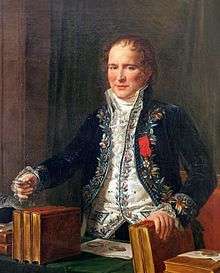Antoine François, comte de Fourcroy
| Antoine François, comte de Fourcroy | |
|---|---|
|
French chemist | |
| Born |
15 June 1755 Paris |
| Died |
16 December 1809 (aged 54) Paris |
| Citizenship | French |
| Nationality | French |
| Fields | chemistry |
| Doctoral advisor | Jean Baptiste Michel Bucquet |
| Doctoral students | Louis Nicolas Vauquelin |
| Known for |
Co-discovered Iridium Co-founded modern chemical nomenclature |
Antoine François, comte de Fourcroy (15 June 1755 – 16 December 1809) was a French chemist and a contemporary of Antoine Lavoisier. Fourcroy collaborated with Lavoisier, Guyton de Morveau, and Claude Berthollet on the Méthode de nomenclature chimique, a work that helped standardize chemical nomenclature.
Life and work
Fourcroy was born in Paris, the son of an apothecary in the household of the Duke of Orléans. On the advice of the anatomist Félix Vicq-d'Azyr (1748–1794) he took up medical studies, and after many difficulties caused by lack of means he finally obtained his doctor's diploma in 1780. Fourcroy's attention was turned specifically to chemistry by J. B. M. Bucquet (1746–1780), the professor of chemistry at the Medical School of Paris. In 1784 Fourcroy was chosen to succeed P. J. Macquer (1718–1784) as lecturer in chemistry at the college of the Jardin du Roi, where his lectures attained great popularity.

Fourcroy was one of the earliest converts to the views of Lavoisier, which he helped to make widely known by his own voluminous writings. The Royal Society's Catalogue of Scientific Papers enumerates fifty-nine memoirs by Fourcroy alone, and fifty-eight written with others, mostly Louis Nicolas Vauquelin. Fourcroy's 1785 publication, Entomologia Parisiensis, sive, Catalogus insectorum quae in agro Parisiensi reperiuntur ..., co-written with Étienne Louis Geoffroy, was a major contribution to systematic entomology.
Although Fourcroy's name appears on a large number of chemical and also physiological and pathological memoirs, he was as much a teacher and an organizer as an original investigator. While a member of the committees for public instruction and public safety, and later, under Napoleon I, director-general of instruction, Fourcroy took a leading part in the establishment of schools for both primary and secondary education, scientific studies being especially provided for.
In 1801, he was elected a foreign member of the Royal Swedish Academy of Sciences.
Fourcroy died in Paris on December 16, 1809, the very day on which he was created a count of the French empire. He is buried in the Père-Lachaise Cemetery in Paris.
It is believed that Cape Fourcroy, at the western tip of Bathurst Island, Northern Territory, Australia, is named after Fourcroy. The cape was named during Baudin's expedition to Australia, and it is known that Baudin had a copy of one of Fourcroy's texts with him on the Géographe.[1]
Controversy
By his conduct as a member of the Convention, Fourcroy has been accused of contributing to Lavoisier's death. Baron Cuvier, in his Eloge historique of Fourcroy, repelled such charges. The Encyclopædia Britannica Eleventh Edition says that although active, though secret, participation cannot be proved against Fourcroy, he can scarcely be acquitted of time-serving indifference. See the works in the Bibliography below for other opinions.
Bibliography

- Louis Bernard Guyton de Morveau, Jean-Henri Hassenfratz, Antoine-François Fourcroy, Antoine-Laurent Lavoisier, Pierre-Auguste Adet, Claude Louis Bertholet Méthode de nomenclature chimique (Paris, 1787)
- Fourcroy, A. The Philosophy of Chemistry (1792)
- Fourcroy, A. A General System of Chemical Knowledge (11 volumes, 1801–1802)
- Kersaint, G. Mémoires du Muséum National d'Histoire Naturelle, Antoine François de Fourcroy, sa vie et son oeuvre, Editions du Muséum, Centre National de la Recherche Scientifique, 1966, p. 59
- Smeaton, W. "Fourcroy, 1755 -1809", Heffer & Sons, Cambridge, 1962, p. 58 - Discusses reasonable evidence that Fourcroy not only saved several physicians/scientists but also that he tried to save Lavoisier at the cost of his own safety
References
- ↑ "The Discovery and Exploration of Australia". australiaoncd.com.au. Retrieved 25 October 2010.
 This article incorporates text from a publication now in the public domain: Chisholm, Hugh, ed. (1911). Encyclopædia Britannica (11th ed.). Cambridge University Press.
This article incorporates text from a publication now in the public domain: Chisholm, Hugh, ed. (1911). Encyclopædia Britannica (11th ed.). Cambridge University Press.
External links
|
